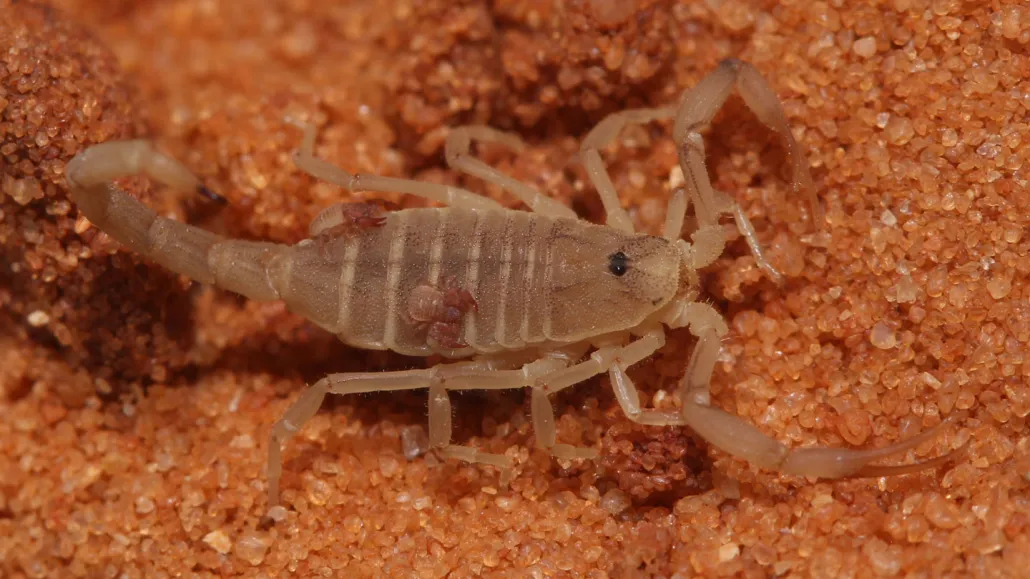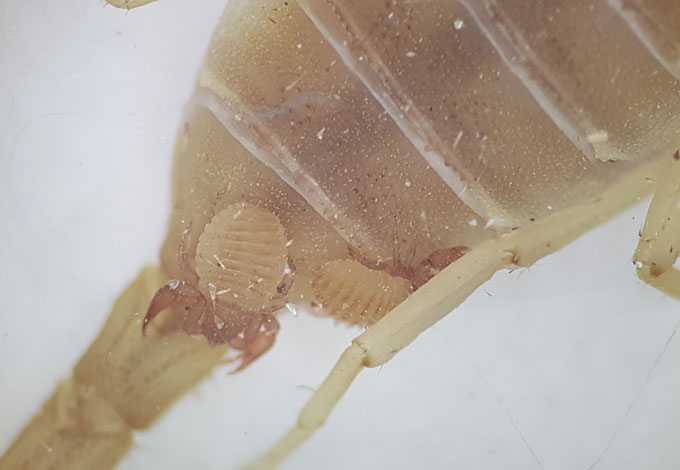
A pseudoscorpion (Nannowithius wahrmani) hitches a ride on the back of a scorpion (Birulatus israelensis), possibly to infiltrate and feed on other tiny animals within ant nests.
S. Aharon
In the middle of an April night in Israel’s Jordan Valley, Yoram Zvik sweeps a UV light over the dark ground near throngs of marching ants. The light passes over the brilliant blue-green fluorescence of a scorpion clambering alongside the ant trail. Peering closer, Zvik — a scorpiologist at the University of Haifa — sees black specks on the scorpion’s glowing back. But they aren’t dirt or sand. They’re alive, and unlike their venom-tailed transport, the stowaways don’t fluoresce under UV light, which betrays their location.
The millimeter-long creatures (about one-twentieth the length of the scorpions) are pseudoscorpions. They have eight legs and claws like their much larger arachnid relatives but lack a stinging tail. Pseudoscorpions commonly get around by hitching rides on much larger animals such as bats, birds and beetles. Zvik’s nighttime discovery reveals for the first time that scorpions can act as the transport too.
The finding, reported in December in Arachnologische Mitteilungen: Arachnology Letters, is just the latest illustration of how ant nests are miniature ecosystems. Well-defended by ant armies and loaded with food, no wonder the scorpions and their hangers-on want to move in.
Zvik first got an inkling of this network of tiny tenants in 2016. Searching for Birulatus israelensis scorpions in the wild, he found them walking along trails made by foraging Messor harvester ants. Zvik and colleagues suspected that the scorpions were living within the ant colonies. Ants in the colony don’t seem to recognize the scorpions as threats, and the sting-bearing sojourners skitter in and out of the nest freely. B. israelensis appears to be the only known scorpion myrmecophile — a creature that lives in close association with ants.
Lab experiments between 2019 and 2022 revealed that the scorpions have an appetite for ant larvae. “So, they probably exploit [the ants],” Zvik says.
Then came the pseudoscorpion piece of the puzzle. One B. israelensis collected in 2018 had two pseudoscorpions gripping its back and hanging on for dear life. Over the next five years, the researchers collected many more scorpions — all without pseudoscorpions in tow. It was unclear whether that one observation was a fluke. But that spring night in 2023 in the Jordan Valley, Zvik found seven scorpions, each with at least two pseudoscorpions along for a ride. One of those scorpions carried six wee passengers.

Zvik and his then-advisor Efrat Gavish-Regev, an arachnologist at The Hebrew University of Jerusalem, reached out to Sharon Warburg, a pseudoscorpion expert also at the university. Together, the researchers characterized this arthropod rodeo in more detail.
The pseudoscorpion, identified as Nannowithius wahrmani, probably uses the scorpion as a shuttle to disperse among ant colonies, the team suspects. That may help the pseudoscorpion infiltrate the nest where it can feed on mites and other small prey within.
Paula Cushing, an evolutionary biologist at the Denver Museum of Nature & Science, agrees this strategic taxiing is likely. Scientists have documented a similar situation in a myrmecophilous spider, she says. Attacobius attarum lives with leaf-cutter ants (Atta sexdens) and uses them as taxis to move between colonies.
It’s not clear how the ants benefit from such arrangements, if at all. But Zvik thinks the pseudoscorpions could have a more reliable ride than the spiders Cushing describes.
“The ant goes out, collects some food and goes back to the same colony,” Zvik says. “The scorpion probably moves to another colony” because, like the pseudoscorpion, it too may be looking for the next feast. In other words, a perfect match of motivations.






